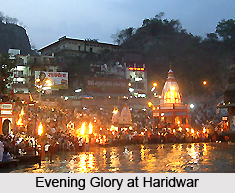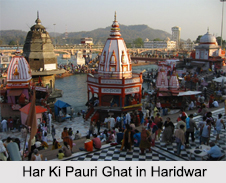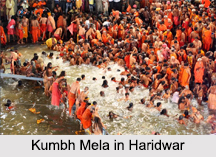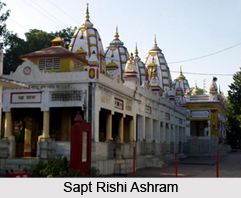 Haridwar is an ancient city and important Hindu pilgrimage site in North India`s Uttarakhand state, where the River Ganges exits the Himalayan foothills. The largest of several sacred ghats, Har Ki Pauri hosts a nightly Ganga Aarti in which tiny flickering lamps are floated off the steps. Worshipers fill the city during major festivals including the annual Kanwar Mela.
Haridwar is an ancient city and important Hindu pilgrimage site in North India`s Uttarakhand state, where the River Ganges exits the Himalayan foothills. The largest of several sacred ghats, Har Ki Pauri hosts a nightly Ganga Aarti in which tiny flickering lamps are floated off the steps. Worshipers fill the city during major festivals including the annual Kanwar Mela.
History of Haridwar
In the scriptures Haridwar was also mentioned as Kapilasthana, Gangadwara and Mayapuri. It is also an entry point to the Char Dham i.e. Badrinath, Kedarnath, Gangotri, and Yamunotri. Shaivaites (followers of Lord Shiva) and Vaishnavites (followers of Lord Vishnu) call this place Hardwar and Haridwar respectively, corresponding to Hara being Shiv and Hari being Vishnu. In the Vanaparva of the Mahabharat, where sage Dhaumya tells Yudhishthira about the tirthas of India, Gangadwar, i.e., Haridwar and Kankhal, have been referred to, the text also mentions that Agastya Rishi performed penance here, with the help of his wife, Lopamudra.
The legendary King, Bhagiratha, the great-grandson of the Suryavanshi King Sagar, is said to have brought the river Ganges down from heaven, through years of penance in Satya Yuga, for the salvation of 60,000 of his ancestors from the curse of the saint Kapila, a tradition continued by thousands of devout Hindus, who bring the ashes of their departed family members, in hope of their salvation.
Haridwar came under the rule of the Maurya Empire and later under the Kushan Empire. Archaeological findings have proved that "terra cotta" culture existed in this region. First modern era written evidence of Haridwar is found in the accounts of a Chinese traveller, Huan Tsang, who visited India in 629 AD records Haridwar as `Mo-yu-lo`, during the reign of King Harshavardhan. Among the ruins, there is a fort and three temples, decorated with broken stone sculptures. He also mentions the presence of a temple, north of Mo-yu-lo called `Gangadwara`, Gateway of the Ganges.
 Legends of Haridwar
Legends of Haridwar
According to Hindu Mythology Haridwar is the place where the Yakshas and the Devas got the spectacle of Lord Vishnu. It is the sacred place which is venerated as the gateway to Lord Vishnu. In the ancient years, Haridwar was known by various names like Mayapuri, Gangadwar and Tapovan. Haridwar is among the four places where once after every twelve years Kumbha Mela is celebrated. According to the Hindu mythology, Haridwar is the holy spot where Amrit (nectar), the drink of Gods that grants immortality fell. During the Samudra manthan, drops of Amrit, the elixir of immortality, accidentally spilled over from the pitcher while being carried by the celestial bird Garuda. The other three spots are Ujjain, Nasik and Prayagraj. Brahma Kund, the spot where the Amrit fell, is located at Har Ki Pauri and is considered to be the most sacred ghat of Haridwar as it is believed that Lord Vishnu have left his footprint on the stone that is set in the upper wall. It is also the primary centre of the Kanwar pilgrimage, in which millions of participants gather sacred water from the Ganga and carry it across hundreds of miles to dispense as offerings in Shiva shrines.
Geography of Haridwar
Haridwar district is located in the southwest part of the state of Uttarakhand. Its latitude and longitude are 29.96 degree north and 78.16 degree east respectively. It is situated between Shivalik Hills in the North and North East and Ganga River in the South. Haridwar is situated at a height of 1,030 ft from the sea level, between Shivalik Hills in the North and Northeast and the Ganges River in the South. During the summers, the temperature reaches to 40 degree C during the whole day and falls around 15 degree C in night. Winters in Haridwar are shivering and chilly. The temperature varies between 0.6 degree C to 16 degree C and the months that face winters in the city are from October to February but the climate during this season is quite pleasant to get there.
The Ganges emerges from the mountains to touch the plains. The water in the river Ganges is mostly clear and generally cold, except in the rainy season, during which soil from the upper regions flows down into it. The river Ganges flows in a series of channels separated from each other called aits, most of which are well wooded. Other minor seasonal streams are Ranipur Rao, Pathri Rao, Ravi Rao, Harnaui Rao, Begham Nadi etc.
Population of Haridwar
According to the census of 2001, Haridwar has a population of 2, 95,213. There are more males than females in the region and the literacy rate in Haridwar is 70 % and the literacy rate among males is more than the literacy rate of females and the population under the age of six in the region is equal to 6 percent.
 Education of Haridwar
Education of Haridwar
There are several premium institutes in the region like Indian Institute of Technology, Roorke, College of Engineering Roorke, Gurukul Kangri Vishwavidyalaya and a lot more. Besides the institutes of higher education there are also several schools like the Delhi Public School and Kendriya Vidyalaya which looks into the need of primary education of the children of the region. Many of the local dialects spoken in Haridwar, but the most commonly used languages like Hindi, English and Urdu.
Festivals and Cultures of Haridwar
Set amidst beautiful mountainous landscapes, Haridwar is one of the greatest centers of classical music and art forms. As per religious beliefs, god has left his footprints in this holy city and the folk songs of the land still chant that incident. Festivals and fairs are integrally associated with culture of Haridwar. The main festivals celebrated in Haridwar are Baisakhi, Diwali, Kartik Purnima, Holi, Ardh Kumbh Mela and Kumbh Mela. Among these all, Kumbh Mela is the most famous one and lots of people from different nook of the country comes here to get involved in this fair. Apart from the usual Hindu festivals, Kanwar Mela and Somvati Amavasya Mela are celebrated with great fervor and respect. The Kanwar Yatra is an annual pilgrimage of devotees of Shiva, known as Kanvarias to Hindu pilgrimage places of Haridwar, Gaumukh and Gangotri in Uttarakhand to fetch holy waters of Ganges River. The festivals run during the monsoon month Shraawan (July -August). An inherent part of Haridwar`s culture is its Yoga Ashrams. These Yoga Ashrams are the learning centers of this age old Indian spiritual and physical practice.
 Tourism in Haridwar
Tourism in Haridwar
Haridwar is the heart of the pilgrimage centers of Uttarakhand. Haridwar is also called Ganga-Dwara, because the holy Ganges enters the plains here. The popular centers of pilgrimage of Haridwar are namely the Gangadwara, Kushwart, Bilwa Teerth, Neel Parvat and Kankhal. Some of the popular temples of the region are Vaishno Devi temple, Gauri Shankar Temple and Bharat Mata temple. There are several spiritual places in Haridwar which gives solace and mental peace to the visitors. Among these are the Anandamayee Ma Ashram and the Daksha Mahadev temple.
Chila Wildlife Sanctuary is one of the popular places of adventure. There are many places around the region like Neel Dhara Pakshi Vihar, Bhimgoda Tank, JaiRam Ashram, Sapt Rishi Ashram and Sapt Sarovar, Parad Shivling, Doodhadhari Barfani Temple and Sureshwari Devi Temple which satisfies a visitor to the fullest extent.
Food of Haridwar
Being one of the popular Hindu pilgrimages, Haridwar restaurants offer pure vegetarian dishes to its visitors. The dishes prepared in these restaurants and even roadside food stalls are hygienically prepared. One can find the different cuisines but only vegetarian on all the restaurants. All types of non-vegetarian dishes and alcoholic drinks are strictly prohibited in the city. There are myriad restaurants offering South Indian cuisine also, apart from the popular Punjabi food, Bengali food and also North Indian food. Some street foods that are famous in Haridwar are Aloo Puri, Kachori, Rasmalai, Jalebi, Chhole Bhature, Lassi, Kulhar Wala, Chaat, Samosas, Fresh Fruit Chaat, Flavoured Kulfi, Stuffed Parathas, Gulab Jamun, Mulberry Khomcha etc.
Visiting Information
Haridwar is reachable by all means of transports. The nearest airport is the Jolly Grant airport, Dehradun. There are frequent trains connected from the major cities of Mumbai, Delhi, Agra, Howrah, Varanasi, Allahabad, Ujjain, Amritsar, Lucknow and so on. Haridwar is situated on the main highway no. 45 that is well connected to all major cities and states that are Agra, Ambala, Badrinath, Delhi, Dehradun, Kedarnath, Saharanpur, Nainital etc.



















